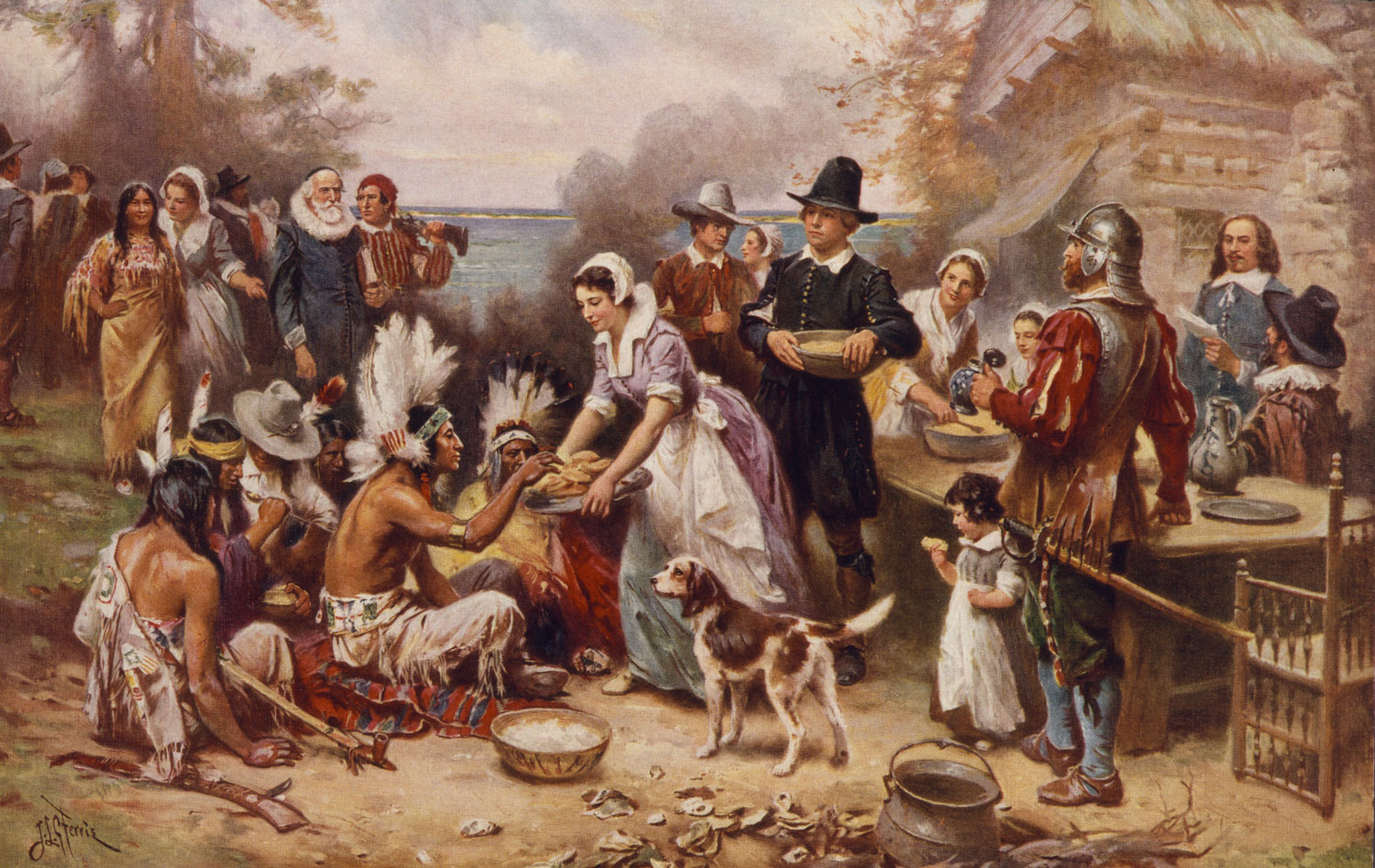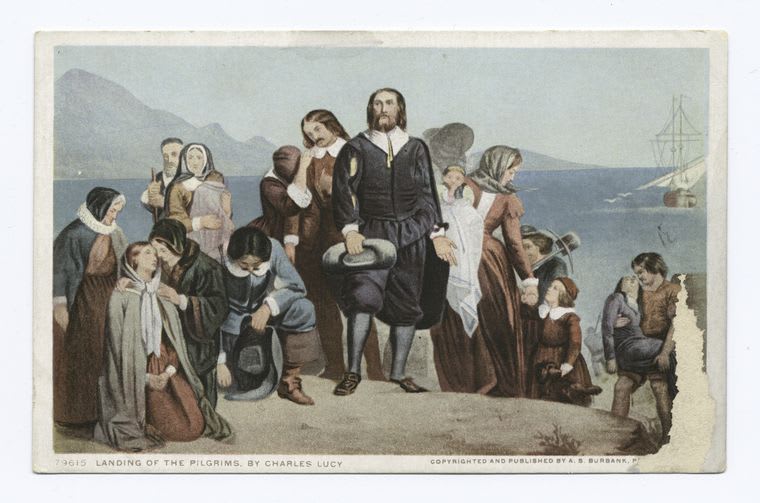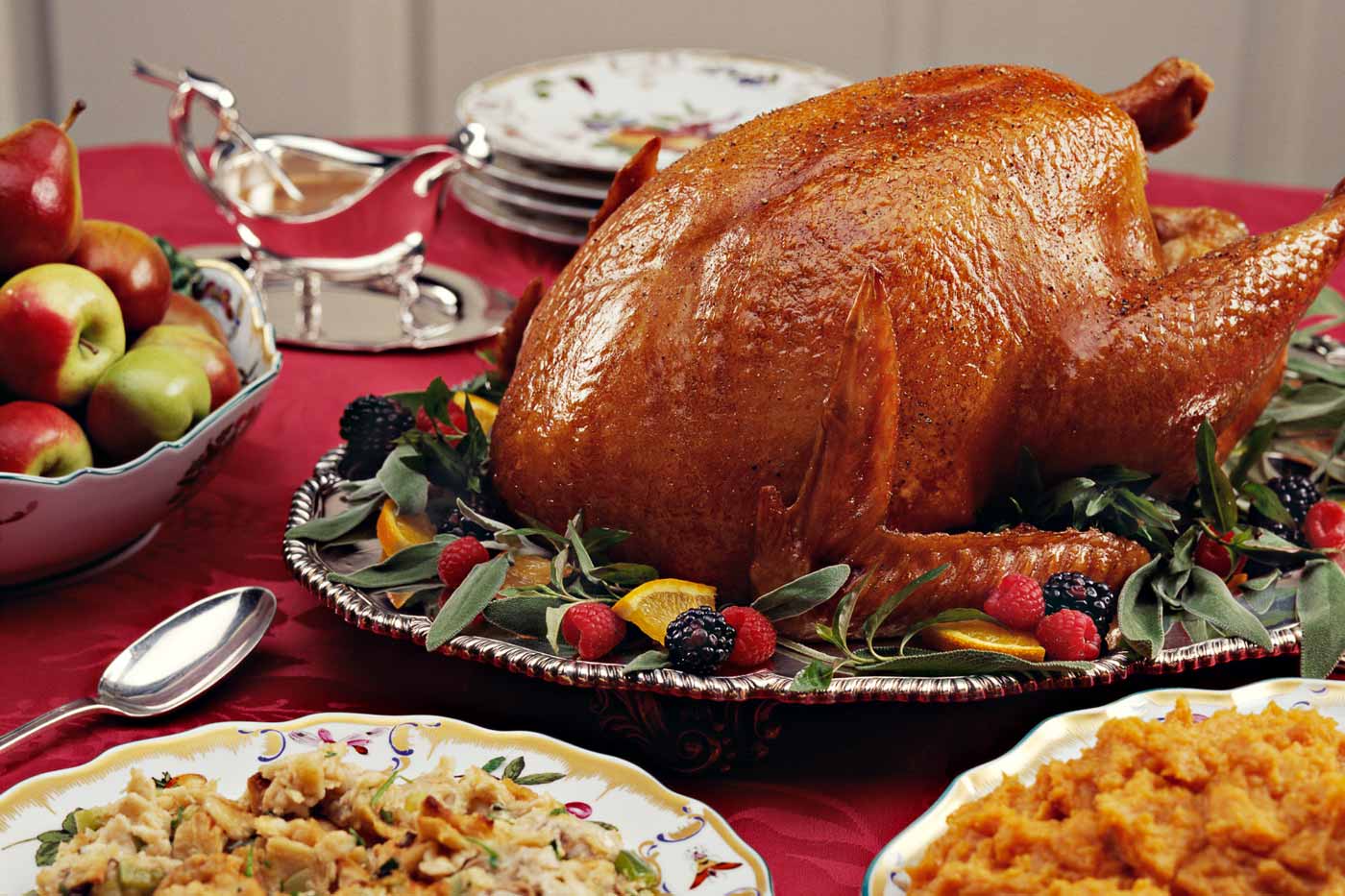It’s a simple story. The Pilgrims stepped off the Mayflower searching for religious freedom. The Native people they encountered welcomed them and helped them survive. To celebrate their friendship, they sat down together to a Thanksgiving feast. This is the traditional tale of the First Thanksgiving.

But was this meal a Thanksgiving? And was it the first?

Something like this happened in Plymouth Colony, Massachusetts, in 1621. Only one historical account exists. In one paragraph of a letter, Edward Winslow wrote that a good harvest led the colony to “rejoyce together.” Part of their celebrations included firing guns. The sound of firearms attracted their Wampanoag neighbors, who probably thought a battle had broken out. Finding a celebration instead, ninety Wampanoag people attended the celebrations. After a quick hunt, they brought deer for the meal. Together, the Plymouth colonists and the Wampanoag visitors “entertained and feasted” for three days.1
Since he didn’t think it was important, Winslow kept his version of the event brief. He never used the word “thanksgiving.”2 We are left to wonder what the participants thought of it. Did they see this as a thanksgiving feast?

For the Wampanoags, the 1621 celebration was at least partly a diplomatic event. Diseases from Europe had recently ravaged their communities, killing thousands. The epidemic reshaped New England's balance of power. This left the Wampanoags much weaker than their regional rivals the Narragansetts. Wampanoag leader Ousamequin hoped that allying with the colonists would restore their strength.3
Listen to this related Ben Franklin’s World episode
In this episode we speak with Darius Coombs, Director of Wampanoag and Algonquin Interpretive Training at the Plimoth Patuxet Museums and a citizen of the Mashpee-Wampanoag nation; Lorén Spears, Executive Director of the Tomaquag Museum and a citizen of the Niantic-Narragansett nation; Jade Luiz, Curator of Collections at Plimoth Patuxet Museums and a historical archaeologist; and Andrew Lipman, an Associate Professor of History at Barnard College and the author of the forthcoming book The Death and Life of Squanto.
Listen to this related Ben Franklin’s World episode
In this episode we speak with Darius Coombs, Director of Wampanoag and Algonquin Interpretive Training at the Plimoth Patuxet Museums and a citizen of the Mashpee-Wampanoag nation; Carla Pestana, author of The World of Plymouth Plantation; Jade Luiz, Curator of Collections at Plimoth Patuxet Museums and a historical archaeologist; and Andrew Lipman, an Associate Professor of History at Barnard College and the author of the forthcoming book The Death and Life of Squanto.
For Plymouth's Puritan colonists, this event was also not a day of thanksgiving. They had rejected the non-Biblical holidays found in Catholic calendars. In their place, they observed periodic days of feasting or thanksgiving. When God passed judgment on them with floods, famines, or plagues, they fasted and spent all day in church. When God showed special mercy, they spent all day in church and then ate a quiet meal of thanksgiving.4 Unlike the 1621 feast, Puritan days of thanksgiving were sober, devotional events. They weren’t a time to shoot guns, enjoy secular fun, or invite non-Christian guests.
The first event that Plymouth colonists would have called a thanksgiving came two years later. When rain rescued their crops from drought, they set aside a July day for giving thanks in church.
Listen to this related Ben Franklin’s World episode
As we investigate the lives and experiences of the Pilgrims, Rebecca reveals details about the group we know as the Pilgrims and why they chose to migrate to North America; How the Pilgrims experienced their transatlantic crossing aboard the Mayflower; And information about how the Pilgrims established Plymouth Colony and celebrated the so-called first Thanksgiving.
Colonial leaders continued to proclaim days of thanksgiving for decades. Some of these took a very different tone from the 1621 event. Over time, English settlements expanded into Native territories, causing violence. The peace celebrated between the English and Wampanoag in 1621 did not last long. Colonists sometimes celebrated days of thanksgiving to commemorate violence against Native enemies. In 1676, for example, a day of thanksgiving celebrated the grisly death of Ousamequin’s son Pumetacom.5

Thanksgiving evolved over the years. By the nineteenth century, the holiday focused less on religion and more on nostalgia, family, and togetherness. When Americans rediscovered Winslow's account in 1822, the unremarkable harvest feast of 1621 was elevated to become the “First Thanksgiving.”6 By that time, American Thanksgiving practices had come to resemble that earlier feast.
As it is celebrated today, Thanksgiving has very little to do with Plymouth in 1621. But if that was not the first Thanksgiving, then what was?
Some note that French and Spanish colonists performed ceremonies of thanksgiving in Florida long before Plymouth. In 1564, a group of French Huguenots settled near today’s Jacksonville, gave “God thanks,” and “sang a psalm of thanksgiving unto God.”7 Alarmed by this invasion of Florida, King Philip II of Spain sent an expedition to dispel the French. After enduring a “frightful hurricane,” this group founded St. Augustine in 1565. A priest performed a religious service on the shore, which included some local Timucuans. The admiral leading the expedition then “had the Indians fed and dined himself.” According to one historian, this was the “first community act of religion and thanksgiving” by Europeans in North America.8

In 1578, a group of Englishmen led by Martin Frobisher explored Canada. Separated by a “greate storm” at sea, the party’s ships found each other and reassembled on the coast of Labrador. A preacher exhorted them “to be thankefull to God for theyr strange and miraculous deliverance.” He invited them to “enjoy and accept thankefully whatsoever adventure" God "should appoynt.”9
Another thanksgiving ceremony may have occurred in Virginia in 1619. Thirty-five settlers led by John Woodlief came to Virginia. The Virginia Company instructed them that the day they arrived should become a yearly holiday “as a day of thanksgiving to Almighty god.”10 If the Virginia settlers obeyed orders, they celebrated thanksgiving a year before the Pilgrims landed.
European colonizers often performed such ceremonies expressing gratitude for their survival and prosperity. Crossing an ocean, after all, was very dangerous. Those who survived had much to be thankful for. Besides these claims, some Texans and Mainers believe the first Thanksgiving happened in their states.

But North Americans were giving thanks for harvests, food, and much else long before Europeans arrived. The Haudenosaunee people, for example, have long given a Thanksgiving Address (Ohên:ton Karihwatéhkwen or “The words that come before all else”) before ceremonial gatherings. According to Haudenosaunee knowledge keeper Otsi’tsakén:ra, the address highlights the “importance of gratitude providing a sense of connection with all living things.”11
Despite centuries of war and dispossession, the Wampanoag still live in New England. As participants in the 1621 feast, they are "forever intertwined with the American Thanksgiving myth,” wrote Mashpee Wampanoag tribal chair Cedric Cromwell in 2012. For some, the harmonious story of the “First Thanksgiving” only hides the betrayal and violence that followed it. As Cromwell noted, some tribal members observe Thanksgiving as a “Day of Mourning.”12
While other tribal members celebrate the holiday “in a thoroughly American way,” Cromwell explained, the expression of gratitude “is not something we as Wampanoag people do on a single day, it is a way of life. Every day we give thanks to the Creator, thanks to our ancestors, and thanks to the natural world around us. Today is no different. We give thanks.”13
Further Reading
Sources
- [1] Mourt’s Relation: A Journal of the Pilgrims at Plymouth, ed. Dwight B. Heath (Bedford: Applewood Books, 1963; orig. pub. 1622), 82.
- Nor did Governor William Bradford, who wrote of the harvest but didn’t mention the meal. William Bradford, History of Plymouth Plantation, ed. Charles Deane (Boston: Little, Brown, 1856), 105.
- David J. Silverman, This Land is Their Land: The Wampanoag Indians, Plymouth Colony, and the Troubled History of Thanksgiving (New York: Bloomsbury, 2019), ch. 3–4.
- James W. Baker, Thanksgiving: The Biography of an American Holiday (Lebanon: University of New Hampshire Press, 2009), 17–21.
- Increase Mather wrote that the thanksgiving would celebrate the “wonderful success against the Enemy, which the Lord hath blessed them with.” Increase Mather, The History of King Philip’s War (Boston: Samuel Drake, 1862), 196. Additionally, in 1637, after English colonists set fire to a wooden Pequot fort in Connecticut, they proclaimed a day of thanksgiving and praise. Baker, Thanksgiving, 27; Silverman, This Land is Their Land, 353.
- Baker, Thanksgiving, 13, 62–69.
- Quoted in “A French Huguenot Colony (1564) by Réné Laudonnière,” in Albert Bushnell Hart, American history told by contemporaries, vol. 1 (New York: Macmillan, 1898), 114.
- Michael V. Gannon, The Cross in the Sand: The Early Catholic Church in Florida, 1512–1870 (Gainesville: University of Florida Press, 1965), 22, 25–26.
- Richard Collinson, ed., The Three Voyages of Martin Frobisher (London: Hakluyt Society, 1867), 251-52.
- “Sir William Thockmorton, Richard Berkeley, et al., ‘Ordinances Direccons and Instructions to Captaine John Woodlefe,’” in Susan M. Kingsburg, ed., Records of the Virginia Company, 1606-26, vo. 3: Miscellaneous Records (Washington, D.C.: Government Printing Office, 1933), 207. The manuscript version of these instructions is available on the New York Public Library website.
- Otsi’tsakén:ra Charlie Patton, Alicia Ibarra-Lemay, and Louellyn White, “Ohén:ton Karihwatéhkwen and Kanien’kehá:ka Teachings of Gratitude and Connection,” Genealogy 5 (no. 3, 2021), https://doi.org/10.3390/genealogy5030081. See also Robin Wall Kimmerer, Braiding Sweetgrass: Indigenous Wisdom, Scientific Knowledge and the Teachings of Plants (Minneapolis: Milkweed Editions, 2013), 105–117.
- Silverman, This Land is Their Land, 2–4; Lisa Blee and Jean M. O’Brien, Monumental Mobility: The Memory Work of Massasoit (Chapel Hill: University of North Carolina Press, 2019), 184, 203.
- “Mashpee Wampanoag letter from the Chairman to the community, Thanksgiving Day 2012,” Many Hoops. Quoted in Silverman, This Land is Their Land, 421.
